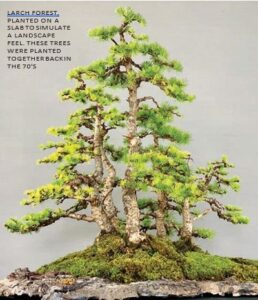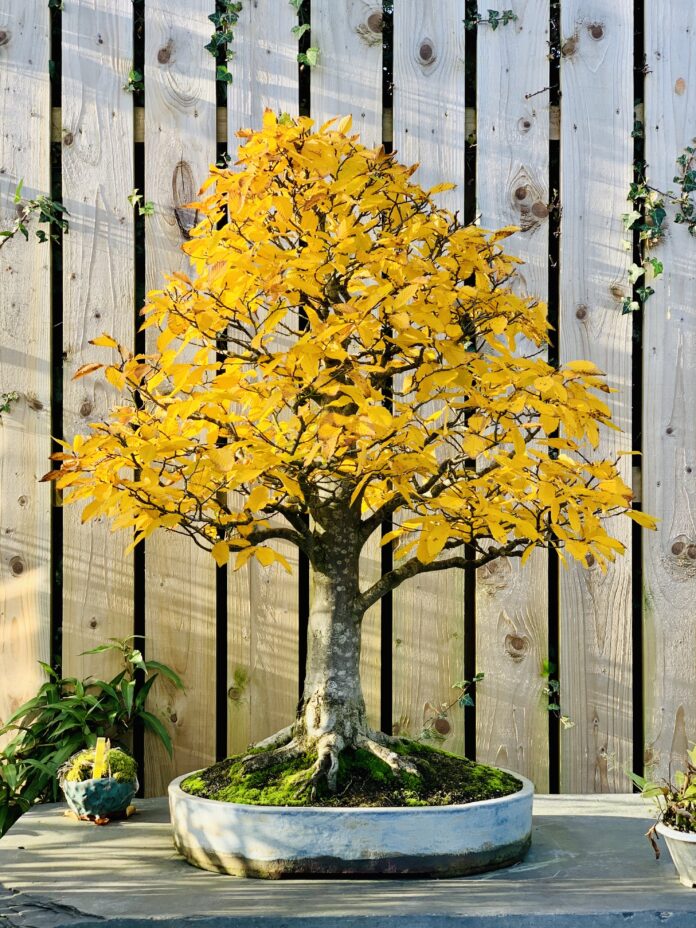Bonsai cultivation is an often misunderstood practice, here Michael Guerin and Dr. Karen O’Hanlon attempt to explain what drives the passion for little trees.
The literal translation of the word Bonsai is simply “tree in a pot” but it means so much more to those who enjoy the practice of the art or hobby. Bonsai entails the cultivation of trees in containers whilst endeavoring to make them look like they have the appearance of a mature example of their species, albeit in miniature. The aim is to apply techniques in the styling and cultivation process in a manner that becomes “invisible”, in other words, the tree takes on a natural appearance in terms of its trunk formation, branch placement, and so on.
The ultimate objective of bonsai culture is to create an aesthetically pleasing composition where a container and tree must form a single entity that will evoke a feeling in the viewer. In order to understand this evocation of feeling, you need to refer to Eastern aesthetic objectives. You will hear these spoken about frequently by bonsai enthusiasts in the west, but many can lack anything more than a rudimentary understanding of these concepts/principles.
IMPERFECT BEAUTY
An often used phrase in the bonsai field is “Wabisabi”, which refers to a Japanese way of living that focuses on finding beauty within the imperfections of life and accepting peacefully the natural cycle of growth and decay. In terms of bonsai what this essentially means is that this philosophy prize attributes in bonsai that would in all likelihood be frowned upon by conventional western society. A good example is where a lower branch has been torn from a coniferous bonsai and rather than being perceived as a fault the deadwood is highlighted and regarded as a beautiful feature, indicative of the struggles the bonsai has had in its life to date. Equally the co-existence of live and dead wood within the one composition is a welcome feature in coniferous bonsai. In an analogous way, gold leaf is sometimes used in ceramics repairs (“Kintsugi”) to highlight an imperfection rather than attempt to conceal it, thereby using the “flaw” of the damage to add character to the piece by drawing one’s eye to it.
A second aesthetic principle that is again often overused and not fully understood is “ Mochikomi”. This refers to when a good quality specimen bonsai exhibits the character of a tree that has grown in a container for many years (sometimes decades or centuries). “Mochikomi” does not focus on a singular attribute that a tree may have but rather views the composition as a whole in terms of characteristics such as bark maturity, reduced leaf/ needle size, and the relative proportions of trunk and branches etc. All of this contributes to an overall aesthetically pleasing composition that strives to evoke feelings of inner humility and insignificance. These feelings not only allow an appreciation of the beauty of the bonsai but can contextualise the viewer’s place in the greater world and the insignificance and transience of day to day troubles. Accordingly, those immersed in bonsai culture will invariably highlight the enhancements that the discipline can bring to their mental wellbeing.
There is a vibrant and thriving group of bonsai enthusiasts in Ireland and the quality of trees has improved dramatically over the past number of years. This is as a result of the importation of quality specimens from Japan and around Europe but also due to the development of “yamadori” or native collected raw species and starting the process of styling them into refined bonsai. Noteworthy native species include Scots Pine and Hawthorn both of which are readily available and have good characteristics for bonsai cultivation.
USE OF BIOLOGICALS IN BONSAI
Contrary to popular belief, bonsai are neither starved nor stunted to maintain their diminutive stature. In fact, there are times of the year when bonsai are aggressively fertilised and encouraged to grow in order to maintain their health and vigour. The application of Plant Growth Promoting Bacteria (PGPB) represents a new and significant departure in improving the health of the trees as it mimics, to some extent, the microbial activity in a container that is commonplace in a native habitat.
This new approach has included the application of biochar coated with specific soil organisms and other liquid cultures for use as organic material and fertiliser substitutes. The advantages of using such high carbon enriched biochar include:
- An increased uptake of minerals into the plant
- The promotion of plant growth and modulation of plant hormones
- A reduction in nutrient runoff
- Increased levels of nutrient retention in a largely inorganic media
Bonsai is about pushing energy internally into the plant (Yin) and holding back growth externally (Yang). To encourage this type of growth, specific microorganisms are selected which exhibit beneficial properties to the bonsai plant. The key functions of these microorganisms include:
-
- The production of cytokinins to enhance lateral growth
- The sequestration of iron – a component in chlorophyll biosynthesis
- The production of highly specific fungicides
- Phosphate solubilisation
- The creation of a rhizosphere that can attract mutually beneficial microorganisms
Bonsai growers have successfully selected organisms that convey the following benefits to the bonsai tree:
- A more effective promotion of plant development
- Enhanced iron sequestration resulting in vibrant leaf colour
- Transferring energy and nutrients into weaker parts of a plant
RESULTS OF RECENT TRIALS
Preliminary trials using PGPB with some bonsai collectors in Ireland commenced in 2019 and have shown encouraging results. Those participating report that the treated plants appear to be more vigorous, healthier in appearance, and have excellent leaf/ needle colour. Significantly, deciduous specimens treated with PGPB appear to have an increased tendency to produce adventitious budding from “old wood” which is considered by many enthusiasts to be an accurate barometer of overall bonsai health and vigour.
One of the struggles with long-term container cultivation is the maintenance of a healthy rhizosphere that is populated with beneficial microorganisms that are conducive to plant health. Once again PGPB treatment is giving encouraging results based on those trees that were repotted in spring 2020. The skillset required for the maintenance of a high-quality bonsai for an indefinite number of years in a container environment is vast and the task is demanding, especially for amateur enthusiasts. You need to put the health of the tree before any stylistic or aesthetic aspirations. The early indications from PGPB use through inoculation of the rhizosphere with specific strains are promising. We have been fortunate to have had the input of Peter Warren from Saruyama Bonsai in the UK who is a Japanese trained, internationally renowned professional along with long-term Irish enthusiasts Ray Egan from Co. Clare and Ian Young from Northern Ireland.
Knowledge and skills in Irish bonsai cultivation are improving all the time which has been due, in part, to the regular visits of professionals from abroad, including those trained by experts from Japan. There are a number of clubs/ groups in both Northern Ireland and the Republic; The latest addition to which is the Limerick/ Clare/ West of Ireland group “Bud Bonsai” which runs meetings, events, workshops, and exhibitions attended by professionals from around the world.
The most important aspect of bonsai enthusiasm is the sense of community and friendship that exists amongst those who pursue their passion for little trees. Bonsai is not so much about producing a refined specimen as enjoying the journey to that endpoint and sharing the trials, tribulations, disappointments, and occasional little victories of bonsai life.
 MICHAEL GUERIN is an avid Bonsai enthusiast and senior addiction therapist with Cuan Mhuire CLG, Ireland’s largest addiction rehabilitation charity. He has been a long term advocate of the use of horticultural therapy in the addiction rehabilitation field.  KAREN O’HANLON is the founder of a microbiological based company called probio carbon Ltd. She has developed a range of bacterial, biochar, and seaweed-based products for use as biological fertilisers, as an alternative to chemical fertilisers. She has coordinated field trials across Europe using these products. KAREN O’HANLON is the founder of a microbiological based company called probio carbon Ltd. She has developed a range of bacterial, biochar, and seaweed-based products for use as biological fertilisers, as an alternative to chemical fertilisers. She has coordinated field trials across Europe using these products.
Contact details: info@probiocarbon.ie / 087-9816569 / www.probiocarbon.ie |







